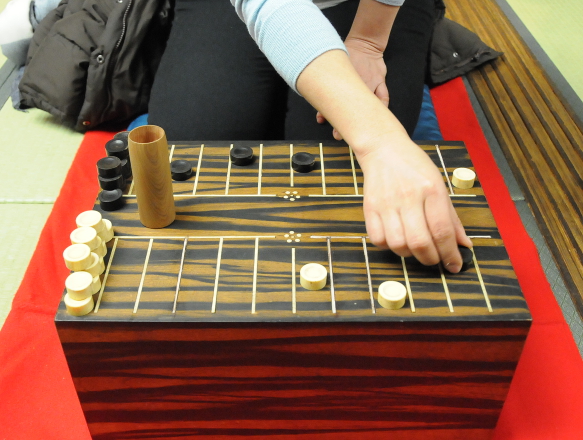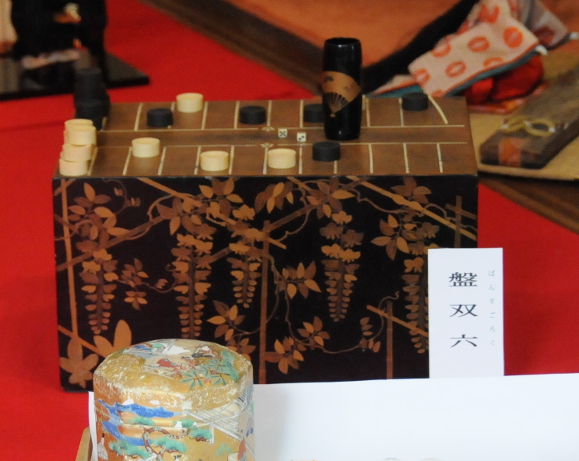By chance, I have come across a very old Japanese board game called Bansugoroku. Just like Go and Shogi (Japanese chess), it was popular at the Heian court in Kyoto some 1000 years ago. However, over time, it became a major game for (illegal) gambling, and when the Edo government cracked down on this and banned gambling, bansugoroku fell out of favour and nowadays is practically forgotten.
That’s a pity because it is actually quite fun to play, a mixture between backgammon and “Mensch ärgere Dich nicht”. You need: A board with 24 fields arranged on opposite sides like shown in the picture below, 15 black pieces for one, and 15 white pieces for the other player, and two dice.  At first, the pieces of each player are piled at one side of the board, and the goal is to bring all pieces to the opposite side where now the other colour is. That means, that the white and black pieces move in opposite directions on the same board, like in backgammon.
At first, the pieces of each player are piled at one side of the board, and the goal is to bring all pieces to the opposite side where now the other colour is. That means, that the white and black pieces move in opposite directions on the same board, like in backgammon.
And this is how to play: After agreeing on who starts, the first player rolls both dice. She is now allowed to move one or two of her pieces according to the result of the dice throw. For example, if you roll a 3 or a 6, you can either move one piece 3 fields forward and the second piece 6 fields, or you move a single piece 9 fields forward. Then, it’s the other player’s turn.
 Sounds simple? The game is not trivial though, since there may only be a single piece on any field: if two pieces of the same colour would fall on the same field, you have to move another piece instead. And if a black piece reaches a field occupied with a white one (or vice versa), then the white piece has to move all the way back to the beginning (just like in Mensch ärgere Dich nicht). Also the final field has to be reached with the correct number of moves – no overshooting allowed! The game is over when one player has moved all his pieces to the opposite side.
Sounds simple? The game is not trivial though, since there may only be a single piece on any field: if two pieces of the same colour would fall on the same field, you have to move another piece instead. And if a black piece reaches a field occupied with a white one (or vice versa), then the white piece has to move all the way back to the beginning (just like in Mensch ärgere Dich nicht). Also the final field has to be reached with the correct number of moves – no overshooting allowed! The game is over when one player has moved all his pieces to the opposite side.
The above are the rules as they were explained to me, but I am sure there are variants of the game. How to approach the finish was a bit unclear for example: If you cannot reach the goal and are not allowed to overshoot, then what do you do? I have been told to turn back at the finish, but it is probably best to wait until you roll the correct number.
 I have since done a bit of research and the Internet in its infinite wisdom insists that bansugoroku was played similar to modern backgammon – with the pieces even laid out on the board in the same way in the beginning. I have found a number of images and woodblock prints from the Edo period of the 18th century which would suggest the same thing. It is possible though that the game was played differently at the Heian court of 1000 years ago and has evolved into a variant or predecessor of backgammon. Since I am not a scholar in the history of Japanese games however, I will leave this open.
I have since done a bit of research and the Internet in its infinite wisdom insists that bansugoroku was played similar to modern backgammon – with the pieces even laid out on the board in the same way in the beginning. I have found a number of images and woodblock prints from the Edo period of the 18th century which would suggest the same thing. It is possible though that the game was played differently at the Heian court of 1000 years ago and has evolved into a variant or predecessor of backgammon. Since I am not a scholar in the history of Japanese games however, I will leave this open.
In any case, as mentioned above, bansugoroku is not played any longer, although some Japanese do play “real” backgammon these days. I wouldn’t mind owning one of those bansugoroku boxes though – aren’t they fabulous? 
